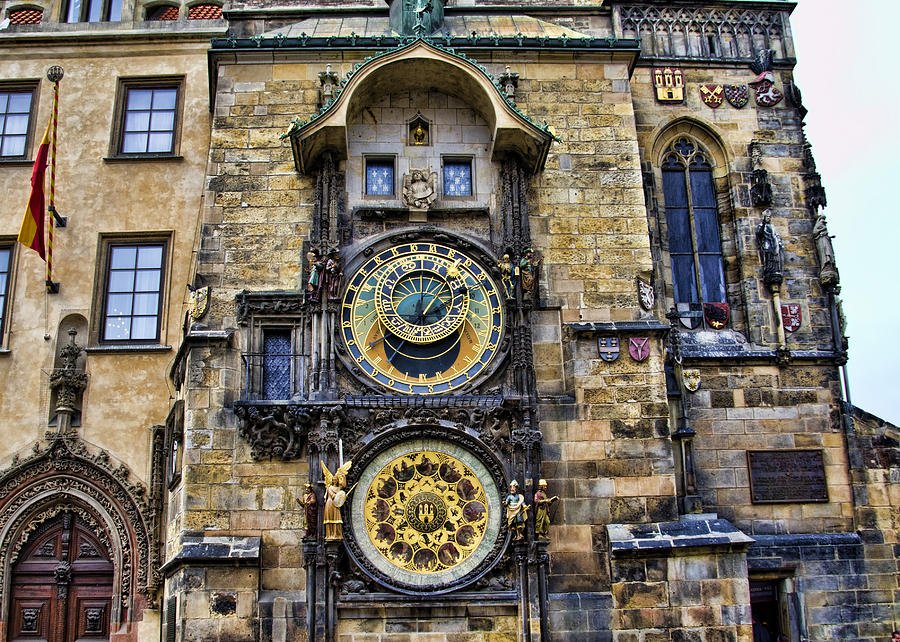The Astronomical Clock in Prague is the world’s oldest astronomical clock still in use. According to the legend, the compelling landmark was created back in the 15th century. The legend goes that Hanus, an experienced clock master, was selected by the city council to produce an original device that will measure time and have other functionalities as well.
The main function of the clock back in the days was to depict the movement of celestial bodies (Sun and the Moon included), with the idea that time was merely a secondary element.
The clock celebrated its 600th anniversary on October 9, 2010. The celebration included a light show on the face of the clock tower, with projectors showing animated videos on the clock. Some of the videos showed the clock being built, torn down, rebuilt, and showing its internal mechanisms.
Six quick facts
– According to the legend, the city of Prague will suffer if the clock is neglected. The Prague City Line believes that if something happens to the clock, if it is ever neglected and falls into disrepair. The legend goes that the skeleton, who is one of the symbols of the clock, will nod its head when it deems that the device has been neglected
– You can view the clock on Google Street View. The service allows you to see the inner workings of the clock, as well as the outside area. That should remind you why you need to go to Prague
– During the Nazi Prague uprising, the clock was severaly damaged. The Nazi sabotaged equipment and historical buildings of Prague, including the clock. The clock didn’t function until 1948 when it was repaired
– The clock is older than the United States. It was built nearly 310 years before the United States of America were discovered. The clock is also a century older than William Shakespeare, and two years before Joan of Arc was born
– The clock was designed by two men, Jan Sindel, a Catholic priest and scientist, and Mikulas of Kadan. The latter was the functional clockmaker, while Jan was the astronomer. Because of that, you can notice influence of religion all over the clock, including the 12 apostles
– The circumference of the calendar is divided into 365 days, with days shifting at midnight. But what happens in a leap year? Simple, the wheel does not move for one night
Quick History
According to many sources, the year when the clock was established was 1410. The exact date was proven only recently, in 1980.
The clock looked vastly different in 1410 than it looks today. The calendar dial, for example, was not added until 1490. Back then, the calendar plate was manually shifted to the next day. Daily shifting was done manually until 1566. In 1566, the clock was fully mechanized, and that included the daily shifting.
In 1570, the first repot about the clock was published. Jan Taborsky of Klokotska Hora described the clock in his Report on the Prague Astronomical clock.
The clock was damaged in 1945 thanks to Nazi uprising. The wooden figures were created of linden wood. Even though the country was in shortage of good quality wood, people were happy to donate for the cause. During the repairs between 1945 and 1948, electric engines were attached to wind the individual cylinders of the mechanism.
The bell and the drum mechanism were set to chime on the hour according to Central European time in 1948. In 1957, the Old Czech Time shown on the 24-hour ring was put back into operation.
In 1979, the clock was repaired again. The bottom plate of the astrolabe was recreated, all the colors were added, and they showed part of the day. The figures were moved to the Prague City Museum in 1976. All of the figures since then used by the clock are copies.
The moving figures story
The moving figures is the main attraction of the clock. The apostle parade can be seen on the clock every hour from 9am to 11pm.
The four figures that are set in motion represent four things that were despised at the time of the making of the clock. The first figure is Vanity, represented by a figure admiring himself in the mirror. The second is greed (usury), which is a miser holding a bag of gold. The third figure, standing across the clock is Death, represented by a skeleton that strikes the time upon the hour. And the final, fourth figure is lust. On the hour, the skeleton rings the bell and all the figures start shaking their head, side to side, which is a sign of their “unreadiness to go”.
In addition to the moving figures, you can also see the statues of the Apostles at the doorways above the clock. All twelve are presented every hour as well.
